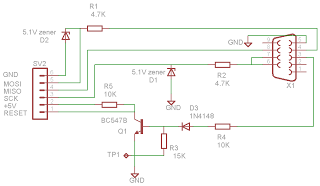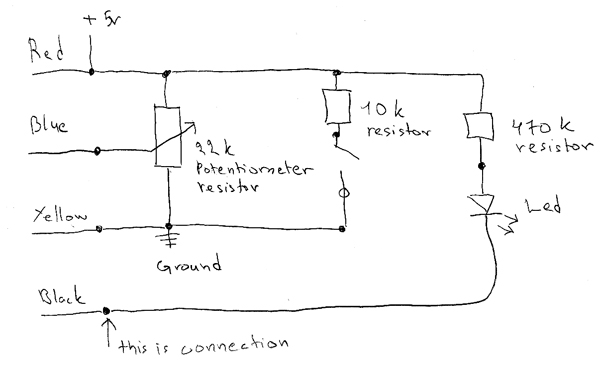
programmer pony prog

There are various types of AVR programmers available in the market; most utilize a parallel port, a serial port (COM port), or USB connectivity. However, these devices can be quite expensive, making them inaccessible for hobbyists. Therefore, a cost-effective AVR programmer has been developed. This programmer can be easily constructed in a short amount of time and requires only a few components, making it economical. This AVR programmer is referred to as the "AVR ISP (In System Programmer)." There are two methods to program the AVR microcontroller: using a socket programmer or in-circuit programming. A socket programmer connects directly to a bare AVR microcontroller, while ISP programmers connect to the microcontroller while it is integrated into the target circuit. This in-circuit programming method allows for the programming of the AVR microcontroller without the need to repeatedly remove it from the circuit, which can lead to pin bending.
The AVR ISP programmer is a practical solution for hobbyists and developers looking to program AVR microcontrollers efficiently and cost-effectively. The design typically includes a microcontroller interface that connects to the target AVR microcontroller's programming pins, which are usually the MOSI (Master Out Slave In), MISO (Master In Slave Out), SCK (Serial Clock), RESET, VCC, and GND pins.
The programmer can be built using a simple microcontroller such as an ATmega8 or ATmega16, which can be programmed to act as a bridge between the computer and the target AVR microcontroller. The connection to the computer can be established using a USB to serial converter, allowing for easy integration with modern computers that may not have parallel or COM ports.
In addition, the programmer's circuit can be designed with a few passive components such as resistors and capacitors to ensure signal integrity and proper operation. A voltage regulator may also be included to provide the necessary operating voltage to the target microcontroller.
To use the AVR ISP programmer, software such as AVRDUDE can be employed, which communicates with the programmer through the USB interface. This software allows users to upload their programs (in HEX format) directly to the AVR microcontroller while it remains soldered onto the target PCB, simplifying the development process and reducing the risk of damaging the microcontroller during handling.
Overall, the AVR ISP programmer is an essential tool for those engaged in electronics projects involving AVR microcontrollers, offering a low-cost and efficient method for programming that enhances the DIY experience.There are many kinds of AVR programmers in market, most of these use the parallel port, a serial port (COM port), or the USB but they are very costly and hobbyist like me can not buy such a costly programmer so i decided to make a cheap AVR programmer. Being a electronics hobbyist I believe in DIY (do it yourself) so here I glad to tell you that m y programmer can be built easily in very short amount of time and since there are only few parts, it is very cheap. This AVR programmer is called "AVR ISP (In System Programmer) programmer". On the AVR microcontroller side there are two possibilities to program the AVR microcontroller, socket and in-circuit.
A socket programmer provides a way to connect just a bare AVR microcontroller to the programmer and ISP programmers however connect to the AVR microcontroller while it is connected to the target circuit. So ISP allows programming of a AVR microcontroller in circuit, avoiding the need to constantly take it in and out of the programmer and the subsequent bending of pins.
🔗 External reference
The AVR ISP programmer is a practical solution for hobbyists and developers looking to program AVR microcontrollers efficiently and cost-effectively. The design typically includes a microcontroller interface that connects to the target AVR microcontroller's programming pins, which are usually the MOSI (Master Out Slave In), MISO (Master In Slave Out), SCK (Serial Clock), RESET, VCC, and GND pins.
The programmer can be built using a simple microcontroller such as an ATmega8 or ATmega16, which can be programmed to act as a bridge between the computer and the target AVR microcontroller. The connection to the computer can be established using a USB to serial converter, allowing for easy integration with modern computers that may not have parallel or COM ports.
In addition, the programmer's circuit can be designed with a few passive components such as resistors and capacitors to ensure signal integrity and proper operation. A voltage regulator may also be included to provide the necessary operating voltage to the target microcontroller.
To use the AVR ISP programmer, software such as AVRDUDE can be employed, which communicates with the programmer through the USB interface. This software allows users to upload their programs (in HEX format) directly to the AVR microcontroller while it remains soldered onto the target PCB, simplifying the development process and reducing the risk of damaging the microcontroller during handling.
Overall, the AVR ISP programmer is an essential tool for those engaged in electronics projects involving AVR microcontrollers, offering a low-cost and efficient method for programming that enhances the DIY experience.There are many kinds of AVR programmers in market, most of these use the parallel port, a serial port (COM port), or the USB but they are very costly and hobbyist like me can not buy such a costly programmer so i decided to make a cheap AVR programmer. Being a electronics hobbyist I believe in DIY (do it yourself) so here I glad to tell you that m y programmer can be built easily in very short amount of time and since there are only few parts, it is very cheap. This AVR programmer is called "AVR ISP (In System Programmer) programmer". On the AVR microcontroller side there are two possibilities to program the AVR microcontroller, socket and in-circuit.
A socket programmer provides a way to connect just a bare AVR microcontroller to the programmer and ISP programmers however connect to the AVR microcontroller while it is connected to the target circuit. So ISP allows programming of a AVR microcontroller in circuit, avoiding the need to constantly take it in and out of the programmer and the subsequent bending of pins.
🔗 External reference





